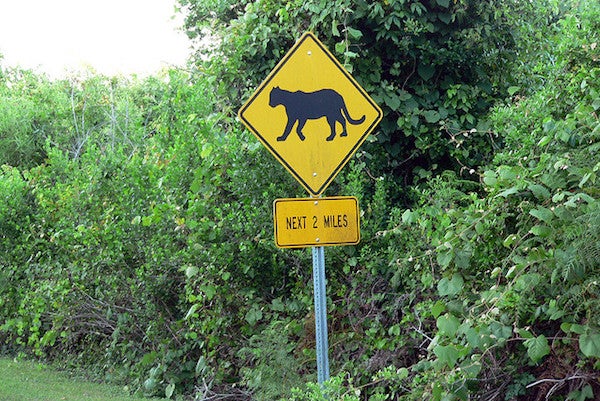This article was published in Scientific American’s former blog network and reflects the views of the author, not necessarily those of Scientific American
Patterns emerge in life, and in death.
Those patterns aren’t always immediately clear. When you first look at this map on the Florida Fish and Wildlife Conservation Commission’s website, all you see is a collection of blue dots, hundreds of them—an amorphous cloud over the southwestern portion of the state.
Last year, according to newly released data, at least 24 Florida panthers died after being struck by vehicles on these and other Florida roads—83 percent of the 30 known panther fatalities in the state in 2017. (Four additional deaths were caused by panthers killing other cats that invaded their territories; two deaths were from unknown causes.)
On supporting science journalism
If you're enjoying this article, consider supporting our award-winning journalism by subscribing. By purchasing a subscription you are helping to ensure the future of impactful stories about the discoveries and ideas shaping our world today.
No one knows exactly how many of the big cats still roam the state, but the most recent estimates put the population at somewhere between 120 and 230 adults and juveniles, a number that’s almost certainly on the decline. According to those estimates, this year’s dead could represent somewhere between 13 and 25 percent of the species’ entire viable population. Even worse, more than a third of this year’s mortalities were breeding-age females, limiting the cats’ chance of bouncing back.
Of course, 2017 didn’t see the highest ever number of annual panther fatalities in the state, but it would be hard to beat the 42 found dead each year in 2015 and 2016, the two worst years on record since the big cats were protected under 1967’s predecessor law to the Endangered Species Act. The total number of vehicular fatalities was also down from the previous two years, but it did represent a new record for the percentage of panthers killed by vehicles.
Fortunately, even amidst the deaths there’s some sign of life. At least 19 panthers are known to have been born during the course of 2017—a slight improvement over the 14 cubs observed in 2016 and the 15 cubs in 2015—but that’s not enough to compensate for the cost of the dead on the population as a whole.
And yes, the pattern of deaths and low birth rates over the past three years has undoubtedly reduced the number of surviving Florida panthers. More of the animals die each year than are being born. “The Florida panther is suffering slow-motion extinction,” said Jeff Ruch, executive director of Public Employees for Environmental Responsibility, in a recent public statement.
What comes next? In all likelihood the news about Florida panthers will continue to be dire. “There are currently no coherent efforts to save the Florida panther from extirpation in the wild, and during a Trump presidency we are unlikely to see one emerge,” Ruch said. In fact the U.S. Fish and Wildlife Service is currently considering whether or not panthers should retain their full protected status under the Endangered Species Act, or even if they should still be considered their own subspecies, a matter of ongoing taxonomic debate.
After more than a decade of writing about these big cats, I expect that without drastic steps the number of Florida panthers killed each year will continue to hit new records as the population declines on a curve toward oblivion. That pattern is clear, and we need to change it.
Zoom in closer and the patterns begin to reveal themselves. The blue dots take on clearer shapes. Toward the Gulf Coast, a dozen dots form a straight line between Fort Myers and Bonita Springs. Another pattern of about 20 dots begins near the city of Naples and stretches out to the east. At one point on that line, roughly 30 miles inland, another straight line emerges, this one heading north and south. This third line is littered with dozens of blue dots.
Only they’re not just dots. Each of these pale blue spots marks the location where a Florida panther has been found dead over the past 46 years.
And the lines? They’re roads. Routes 41, 29 and 75, best known as the Everglades Parkway.
Roads kill, especially if you’re a critically endangered Florida panther.

Credit: Stig Nygaard Flickr(CC-BY-2.0)
Note: This article first appeared in The Revelator on January 8, 2018. Used with permission.